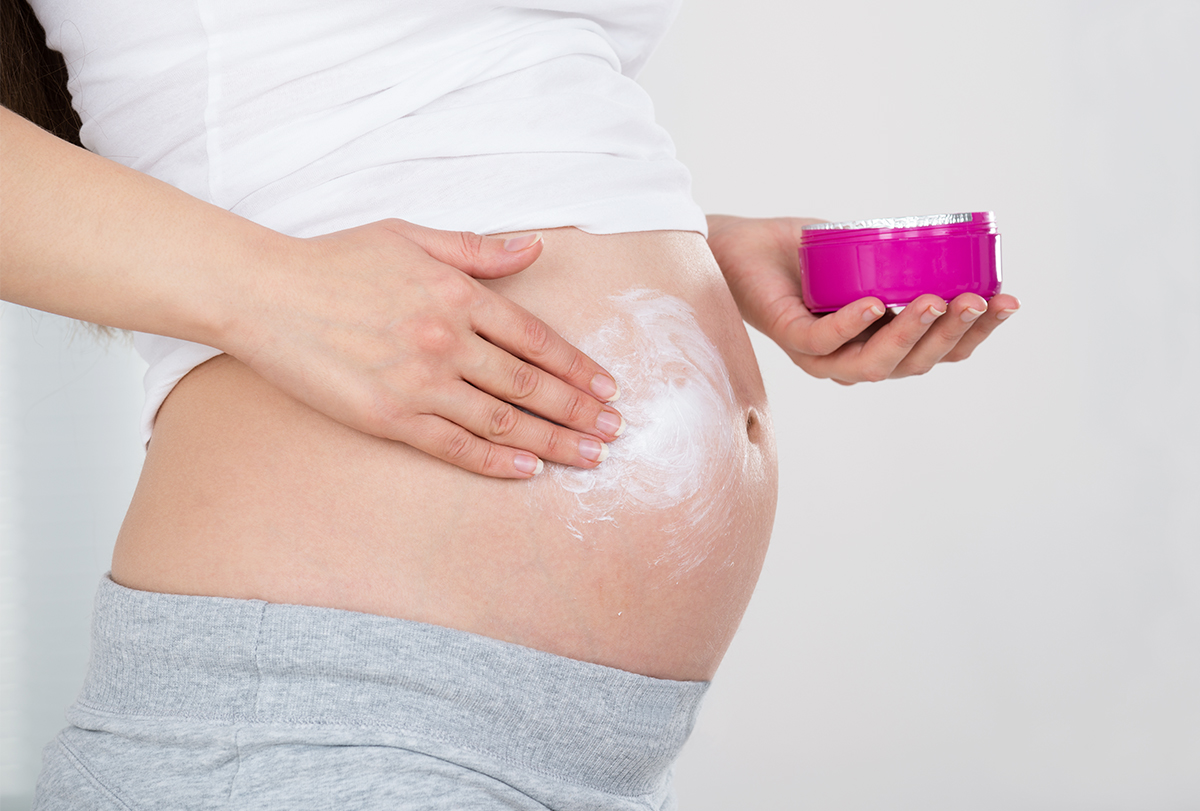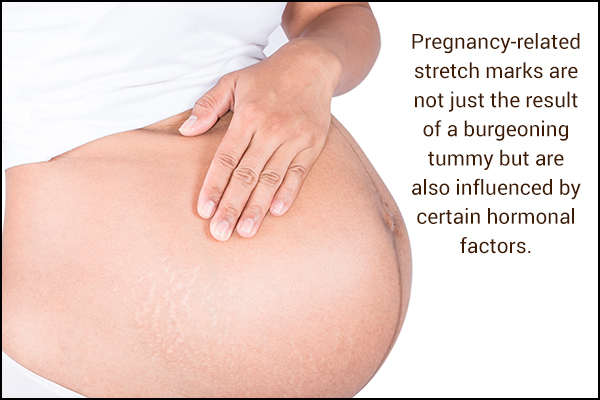In this article:
Stretch marks, or striae distensae, are bands of linear scars that occur due to the overextension of the skin. This typically happens during phases of rapid physical growth, such as adolescence and pregnancy, when your skin is unable to expand fast enough to accommodate the growing body. Thus, the skin is pulled beyond its elastic strength and tears, appearing on the surface as stretch marks.

Striae gravidarum refers to the stretch marks that affect most women during pregnancy to a varying degree. These marks typically appear on the abdomen, breasts, inside of the upper arms, hips, buttocks, and thighs.
While not medically dangerous, their appearance may precipitate both emotional and psychological issues.
What Causes Pregnancy-Related Stretch Marks?

Pregnancy-related stretch marks are not just the result of a burgeoning tummy but are also influenced by certain hormonal factors. One hormone, relaxin, can increase collagen breakdown and decrease collagen production. Relaxin is found in lower levels at 36 weeks in women with stretch marks than in those without stretch marks. (1)
There are also findings of dramatic separation of collagen bundles leading to disorganized collagen fibrils that fail to form the normal collagen bundles seen in normal skin. (2)
These changes most likely result from the ineffective repair of collagen bundles due to disruption by extensive skin stretching that occurs during pregnancy. The persistent disruption of the collagenous extracellular matrix likely promotes the formation of stretch marks and the eventual depressed or atrophic areas.
Risk Factors for Pregnancy-Related Stretch Marks
Women are more likely to develop stretch marks during pregnancy if they have any of the following characteristics:
Preventing Stretch Marks During Pregnancy

Many topical products and therapies claim to prevent or reduce the appearance of stretch marks during pregnancy, but there aren’t enough high-quality studies to verify their effectiveness. (4) These products may be all-natural, but they do not have much, if any, reliable evidence behind their claims.
However, a few natural treatments listed below have shown promising results in reducing the risk or perhaps the severity of stretch marks when used regularly during pregnancy.
Note: Please discuss with your health care provider about what is safe and appropriate for your pregnancy. Everyone is different, and every pregnancy is different.
1. Avoid brisk weight gain
When you gain a lot of weight rapidly, your skin pulls in all directions. This mechanical stress on the skin often leads to tissue tears, contributing to the formation of stretch marks. (5)
It’s completely normal and healthy for you to gain weight when a baby is growing inside you, but it is best if it happens gradually and in a controlled manner. Sudden and excessive weight gain will not give your skin enough time to adjust to the growing body and will put you at a higher risk of stretch marks.
2. Apply hyaluronic acid
Hyaluronic acid is a substance found in all mammals. The use of hyaluronic acid topical creams may increase the tensile strength in the skin, allowing for more resistance to the mechanical forces causing stretch marks. Thus, your skin is able to stretch more without tearing.
The evidence supporting the use of creams with hyaluronic acid to help prevent stretch marks is not overwhelming, but it certainly is quite safe to use during pregnancy. (6)
3. Use Centella asiatica (Trofolastin)
Commonly known as Mandukparni, Indian pennywort, or Jalbrahmi, this medicinal herb has been in use for thousands of years and may prove useful in preventing stretch marks.
It works by blocking the hormonal triggers and stimulating the fibroblasts to help make more robust collagen. However, there aren’t enough studies to confirm its efficacy. (7)
4. Massage bitter almond oil
Nurse-midwives studied the effectiveness of applying bitter almond oil to reduce stretch marks in pregnant women.
They found that the key to success is massaging the bitter almond oil into the skin for at least 15 minutes, as after which only 20% of the women in the massage group developed striae. (8)
5. Moisturize with oils and butters

Olive oil, coconut oil, and cocoa butter are natural moisturizing agents that can help hydrate your skin without getting absorbed into the bloodstream or causing any side effects such as rashes or irritation. The better lubricated the skin, the less likely it is to tear.
While these topical products are quite popular and may provide short-term hydration, none of these have been proven to significantly impact the long-term appearance and persistence of stretch marks. (9)
Olive oil and cocoa butter, in particular, have been well studied and not found to help reduce stretch marks. (9)
Final Word
Most natural treatments available to prevent pregnancy-related stretch marks lack scientific support. Thus, the main recommendation is always to prioritize your safety and consult your ob-gyn before trying any new therapy or product during pregnancy. Just because something is “all-natural” does not mean it’s safe or effective.
While you can try the above-mentioned interventions during pregnancy to diminish the appearance of stretch marks, there are things you can do after delivery as well to fade the scars.
Many women choose not to do anything about their stretch marks and embrace them as reminders of a beautiful, life-changing experience. This is completely reasonable too. Indeed, growing a life inside you is no less than a miracle!
- Was this article helpful?
- YES, THANKS!NOT REALLY


